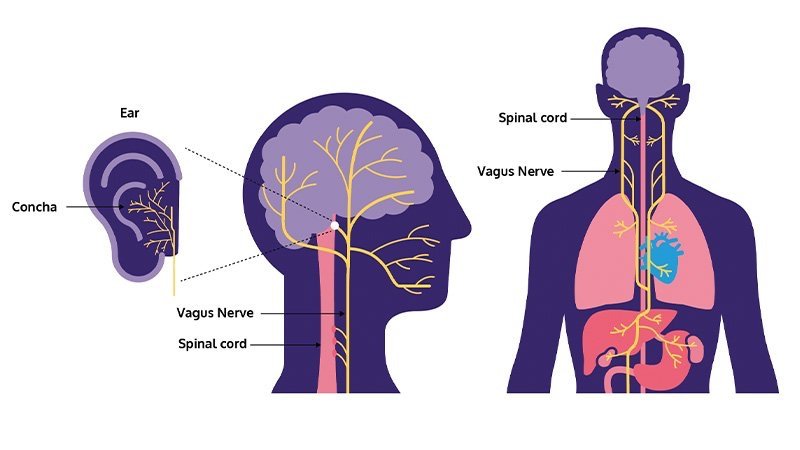General Introduction to Polyvagal Theory
Polyvagal Theory, introduced by Dr. Stephen Porges in his seminal book The Polyvagal Theory: Neurophysiological Foundations of Emotions, Attachment, Communication, and Self-regulation (2011), has transformed how clinicians understand human behavior, emotions, and physiological responses. Rooted in neurophysiology, this theory offers an insight into the connection between the autonomic nervous system (ANS) and our emotional regulation, social engagement, and overall mental health.
Porges’ theory extends beyond the classical understanding of the ANS, which traditionally divided responses into the sympathetic (fight-or-flight) and parasympathetic (rest-and-digest) branches. Polyvagal Theory identifies a third pathway, the social engagement system, mediated by the vagus nerve, which plays a central role in regulating emotional and physiological states. This innovative framework has profound implications for understanding conditions such as anxiety, trauma, and depression, highlighting how physiological states influence psychological well-being and interpersonal dynamics.
The clinical significance of Polyvagal Theory lies in its capacity to inform therapeutic practices. By addressing the interplay between autonomic states and emotional experiences, psychologists can help clients achieve greater self-regulation, resilience, and promote mental well-being. This blog post can serve as a brief introduction to the intricacies of Polyvagal Theory, examining the role of the vagus nerve, its implications for psychological behaviors, and practical applications for daily life.
The Vagus Nerve and Its Interconnection in the Body
The vagus nerve, the cornerstone of Polyvagal Theory, is the tenth cranial nerve and a critical component of the parasympathetic nervous system. Its name, derived from the Latin word “vagus” meaning “wandering,” aptly describes its extensive reach throughout the body. Originating in the brainstem, the vagus nerve innervates the heart, lungs, digestive tract, and numerous other organs, influencing vital functions such as heart rate, respiration, and digestion (Porges, 2011).

Polyvagal Theory distinguishes between two vagal pathways: the dorsal vagal complex (DVC) and the ventral vagal complex (VVC). The DVC, the phylogenetically older pathway, governs immobilization responses associated with survival, such as freezing or shutdown during extreme threat. In contrast, the VVC, unique to mammals, supports the social engagement system by modulating heart rate, facial expressions, vocalization, and the ability to connect with others. The VVC’s influence on the heart is mediated through its connections with the sinoatrial node, facilitating a state of calm and safety conducive to social interaction (Porges, 2011; PositivePsychology.com).
The vagus nerve’s bidirectional communication between the brain and body highlights its role in emotional regulation. For example, stress signals originating in the body can activate the dorsal vagal pathway, leading to feelings of disconnection or overwhelm. Conversely, activating the ventral vagal pathway through safe and supportive environments fosters relaxation and emotional balance (Porges, 2011). This intricate network highlights the vagus nerve’s significance in shaping both physiological and psychological experiences.
How Polyvagal Theory Explains Psychological Behaviors
Polyvagal Theory provides a nuanced lens for understanding psychological behaviors, particularly those related to stress, trauma, and attachment. Central to the theory is the concept of ‘neuroception‘, a subconscious process by which the nervous system evaluates environmental cues to determine safety, danger, or life threat (Porges, 2011). This evaluation influences autonomic states, shaping our behavioral responses.
- Safety and Social Engagement: When the ventral vagal pathway dominates, individuals feel safe and socially connected. This state supports open communication, curiosity, and collaboration. It reflects optimal autonomic regulation, enabling individuals to engage positively with their environment and others (PositivePsychology.com).
- Danger and Fight-or-Flight Responses: Perceived threats activate the sympathetic nervous system, leading to fight-or-flight behaviors. While adaptive in the face of immediate danger, chronic activation of this state contributes to anxiety, hypervigilance, and difficulty relaxing.
- Life Threat and Immobilization: In situations perceived as inescapably threatening, the dorsal vagal pathway triggers immobilization responses such as dissociation or emotional numbing. These reactions, while protective in extreme contexts, can underlie symptoms of post-traumatic stress disorder (PTSD) and depression when persistently activated (Porges, 2011; Porges, 2009).
Attachment and relational dynamics also align with Polyvagal Theory. Secure attachment correlates with a predominance of ventral vagal states, fostering trust and connection. Conversely, insecure attachment patterns often reflect disruptions in autonomic regulation, such as heightened sympathetic arousal or dorsal vagal shutdown. By addressing these underlying physiological states, clinicians can help clients gain a better understanding of themselves and build healthier relational patterns.
Polyvagal Theory delves deeper into the interplay between physical health and mental well-being. Chronic autonomic dysregulation, such as prolonged sympathetic activation or dorsal vagal dominance, contributes to conditions like cardiovascular disease, gastrointestinal disorders, and immune dysregulation. These findings reinforce the importance of holistic approaches to mental health that integrate physiological regulation (Porges, 2011; Porges, 2009).
Practical Tips and Exercises for Daily Life
Harnessing the principles of Polyvagal Theory offers individuals tools to enhance self-regulation and resilience. Below are practical strategies for engaging the vagus nerve and promoting autonomic balance:
- Breathwork: Slow, diaphragmatic breathing activates the ventral vagal pathway, reducing stress and fostering a sense of calm. Techniques such as the 4-7-8 breathing method (inhale for 4 seconds, hold for 7 seconds, exhale for 8 seconds) can be particularly effective (PositivePsychology.com).
- Mindfulness and Meditation: Practices that cultivate present-moment awareness enhance vagal tone, improving emotional regulation. Meditation techniques that focus on loving-kindness or gratitude also support the social engagement system by promoting feelings of safety and connection.
- Vocalization: Singing, humming, or chanting stimulates the vagus nerve through its connections to the vocal cords and inner ear. These activities not only enhance vagal tone but also foster emotional expression and relaxation (Porges, 2011).
- Physical Movement: Gentle exercises such as yoga, tai chi, or walking help regulate autonomic states by integrating breath and movement. These practices also promote body awareness, aiding individuals in recognizing and responding to physiological cues.
- Social Connection: Engaging in supportive relationships and meaningful social interactions activates the ventral vagal system, reinforcing feelings of safety and belonging. Therapies that emphasize relational dynamics, such as emotionally focused therapy, align with this principle (PositivePsychology.com).
- Cold Exposure: Brief exposure to cold, such as splashing cold water on the face or taking cold showers, can activate the vagus nerve and enhance its regulatory functions. This practice should be approached cautiously, particularly for individuals with health conditions.
- Body Scans and Progressive Muscle Relaxation: These techniques promote self-awareness and help release physical tension associated with sympathetic activation. They are particularly useful for grounding and reducing anxiety (PositivePsychology.com).
- Therapeutic Interventions: Trauma-focused therapies, such as somatic experiencing or eye movement desensitization and reprocessing (EMDR), integrate principles of Polyvagal Theory by addressing autonomic dysregulation and restoring a sense of safety (Porges, 2011; Porges, 2009). If you have more questions about how therapy can benefit your mental well-being, please feel free to reach out.
By incorporating these practices, individuals can enhance their ability to navigate stress, build resilience, and foster emotional well-being. Clinicians play a crucial role in guiding clients toward these strategies, tailoring interventions to their unique needs and contexts.
To sum up
Polyvagal Theory offers a groundbreaking framework for understanding the interplay between physiology, emotion, and behavior. By illuminating the role of the vagus nerve and its pathways, this theory provides a biologically informed foundation for addressing psychological challenges and promoting self-regulation. Clinicians who integrate Polyvagal principles into their practice can empower clients to cultivate resilience, enhance relationships, and achieve greater harmony between mind and body. As research continues to evolve, the insights from this theory will undoubtedly further enrich the field of psychology and the lives of those it serves.



